
Continuing west on the Mereenie Loop road (permit required) which runs from Hermannsburg to Watarrka National Park and Kings Canyon,
we passed the turnoff from the West MacDonnells and Gosse Bluff, with Gosse Bluff dominating the landscape as we continued on.
We saw numerous feral horses, donkeys and camels on the plains.
The landscape changed rapidly when we reached Kata Pata Gap as we left the plains and edged around the ridges and through passes. We reached a lookout giving glimpses to the
The western end of the
Arriving at the
A popular camping alterntive is Kings Creek Station campground for Central Australian outback experiences with the station family who support their special charity Conway Kids.
The morning was fine and clear, so we left early for
Dingoes can be heard howling at night, and we found our sullage hose had been dragged away during the night. Dingoes can be seen foraging
in the campgrounds, even in the day time.
There are two walks; with one at floor level going deep into the canyon and totalling 2.6 kilometres return. We choose the more
challenging rim walk of six kilometres. The climb to the rim starts with a steep ascent to a height of around 100 metres. Steps have been cut into the stone. Even with an early morning start, there were a number of tour groups already climbing up
the trail. This is the only way up as the walk is set to be taken in a clockwise direction.
After a short pause to admire the view, the climb continues.
A few trees survive on top of the ranges, despite the dry and stony environment.
Looking out of the canyon across the plains towards the south west from the rim.
Tilted strata meeting straight strata.
The south wall of the canyon has a sheer drop of around 100 metres to where rubble has made a gentler slope. Iron oxide has stained the surface of the white sandstone. A mysterious series of concentric oval marks on the cliff face can be seen. The explanantion given is not convincing.
Despite signs warning about the dangers of unstable cliff edges, people walked to the edge of the rim.
Ripples on an ancient ocean floor have been captured in these ripple rocks.
Looking back to the bridge and the valley as we climb the other side.
More steps take the walkers back to the top of the canyon.
Back on the roof of the range, this pool of water has persisted in a dry environment.
A little further along the trail, I caught a glimpse of a canyon on our right, and discovered the path took us around to look across
to the most colourful of the canyon walls. We were now on the side of the canyon from where we looked across to the mysterious
circles.
The lighter colour indicates that the slippage is much more recent that the opposite wall, above which we were now standing above. The lightest coloured patches were known to have had slippage as recently as sixty years ago. The dark rusty streaks were formed
by water which had dissolved iron oxide from the rocks leaving the stains from where it trickled down the rocks and evaporated. Algae has left green and black stains. The morning light kept the wall in shadow so the colour of the cliff has not photographed
well.
West MacDonnell Range Cycads grow on top of the range; these are an ancient species from a time when dinosaurs roamed the Earth and
the area was a rainforest. They grow very slowly, and the one on the right is estimated to be 400 years old.
We begin the long descent to the valley floor. This is not as steep as the climb at the start of the Rim Walk. See details of all the walks here
A hundred metres or so below us on the floor of the canyon these dots are a group of people who have just reached the end
of the Kings Creek walk through the canyon floor.
Signage at the start of the Giles Track, which runs from
GILES
TRACK 22 Km 2 Days One Way
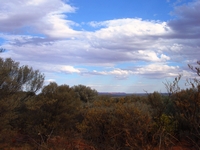
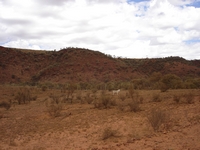
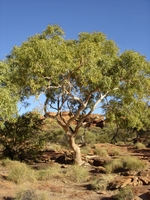
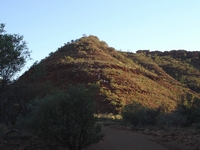
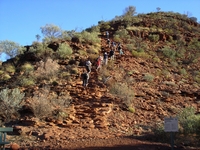
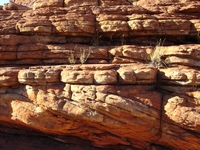
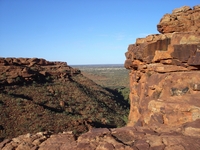
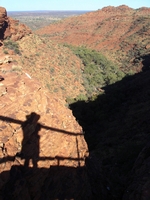
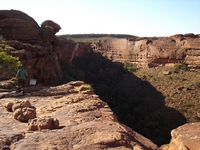
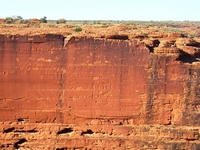
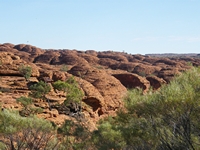
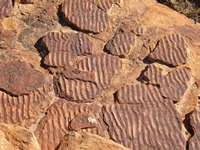
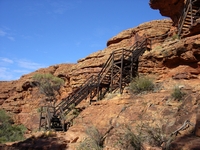
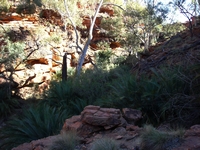
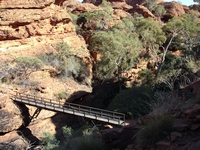
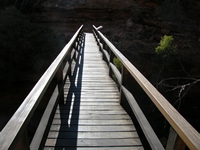
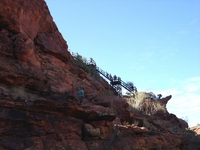
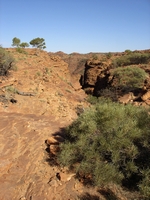
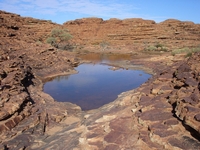
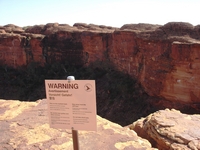
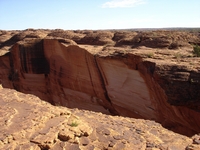
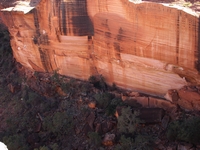
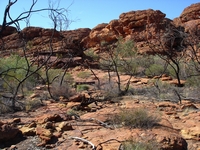
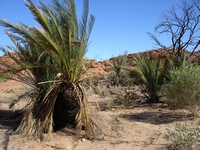
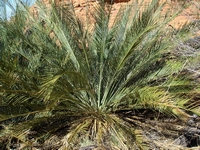
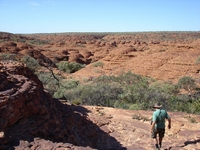
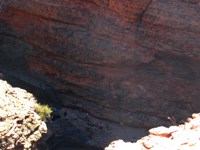
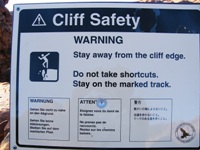
The recently fallen rocks can be seen at the base of the cliff, where vegetation has covered over older falls. The slope of the south face further increases the dangers of walking close to the edge.
For more about which campground to choice see Kings Canyon Resort or Kings Creek Station.
News: El Questro and Kings Canyon Resort are back under Australian ownership, with the purchase of these resorts from Delaware North in February 2021 by G' Day Group Holdings.